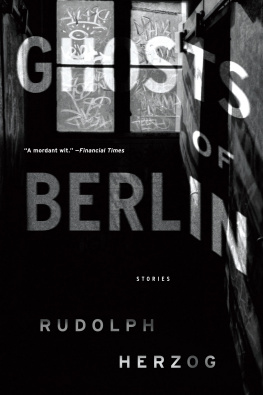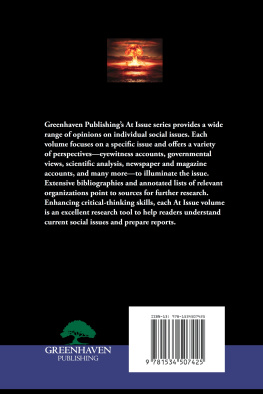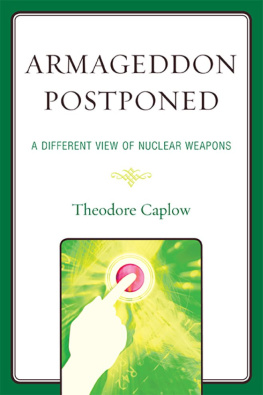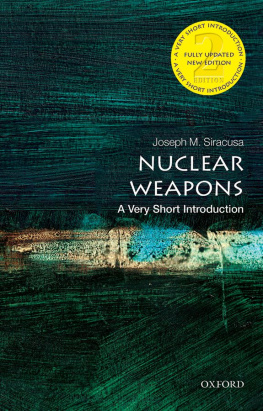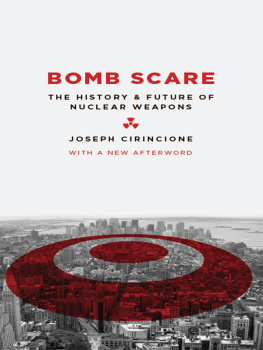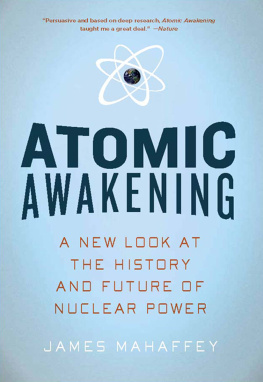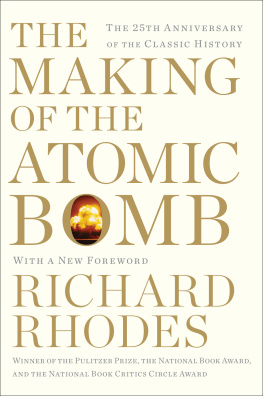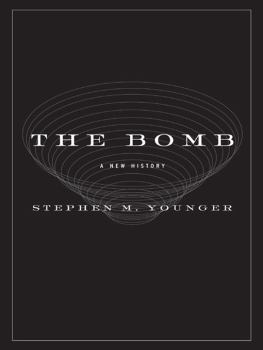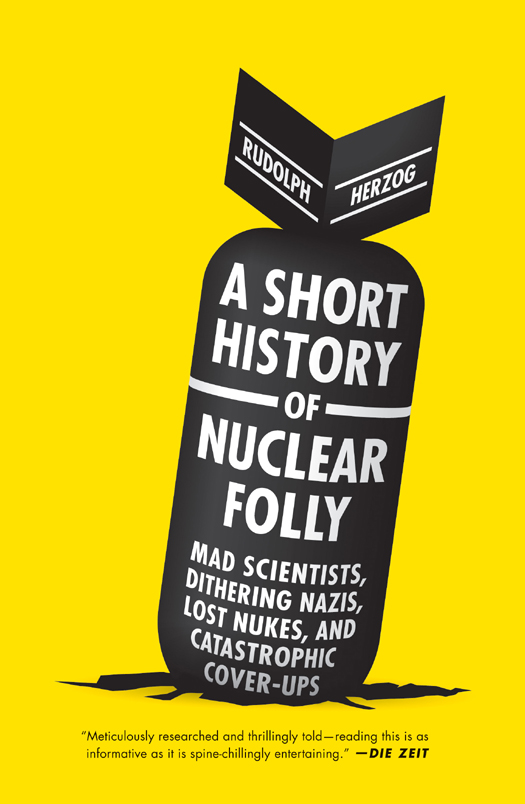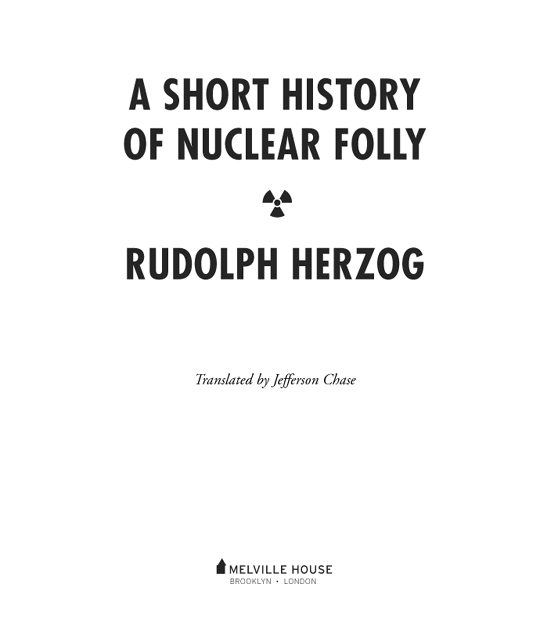A SHORT HISTORY OF NUCLEAR FOLLY
Originally published in German as Der
verstrahlte Westernheld und anderer Irrsinn
aus dem Atomzeitalter by Rudolph Herzog
Published under the Imprint Galiani Berlin
Copyright 2012, Verlag Kiepenheuer & Witsch
GmbH & Co. KG, Kln / Germany
Translation 2013 Jefferson Chase
Melville House
145 Plymouth Street
Brooklyn, New York 11201
mhpbooks.com
eISBN: 978-1-61219-174-4
A catalog record for this title is available from the Library of Congress.
v3.1
Contents
Preface
When I was twelve or thirteen years old, my uncle showed me the barbiturates he kept in his refrigerator. Ill be swallowing them, when the big one comes, he told me. What he meant was the nuclear explosion that he was convinced would turn Germany into a radioactive desert. Ronald Reagan had been president of the United States since 1981, a cadre of unpredictable gerontocrats ruled the Soviet Union, and there was no end in sight to the lunatic arms race the two sides had been pursuing for the past forty years. Soviet jets had just shot down a Korean passenger plane over the island of Sakhalin, and the Americans were planning to install laser weapons in space. In Germany, responsible fathers were building fallout shelters in their backyards. Not even the movies offered a respite from the omnipresent worries about impending catastrophe. One of the big blockbusters of 1983, The Day After, revolved around the radiation-poisoned survivors of a nuclear holocaust, When the Wind Blows featured similar images in animated form, and Atomic Caf mocked the hapless civilian measures ordinary people were supposed to take in the event of a nuclear war.
Everyone knew that Germany was directly in the crosshairs of the atomic conflict. The worlds superpowers had agreed that Central Europe was to be the main battlefield, and our teachers made darn sure we were aware of that fact. A German military officer who came to speak at my school told us about a NATO doctrine known as flexible response. The flexible part was that the Allies could decide to respond to a potential attack by the Soviet Union with conventional or nuclear weapons. The officer couldnt explain how the tiny German Bundeswehr could ever hope to fight a conventional war against the Red Army, and he hinted that in case of Communist attack, a nuclear strike would be more or less unavoidable. The most likely course of history was leading directly into the abyss. American Pershing II missiles were already deployed in West Germany, ready to pay back people on the other side of the Iron Curtain for any acts of aggression.
Then, the Chernobyl disaster happened. The meltdown of the reactor destroyed any faith that atomic energy could be a boon to the world. The apocalyptic mood was complete. In Bavaria, where I lived then, some of the fallout from the accident came down to earth. We kids werent allowed to drink milk, and the principal of my school ran around with a Geiger counter taking measurements. For days, when we went outside for recess, we were told not to sit on the groundthe principal thought that we would become contaminated. I can remember playing Frisbee with my friend Dirk in a farmers field. A woman cycling past yelled at us for trampling on the crops, and Dirk responded that the potatoes were radioactive anyway.
Today, I can hardly imagine that scenes like these were once my reality. The generally depressed mood of the 1980s has dissipated, and the nuclear crosshairs are no longer focused on Germany, but on other parts of the world. The end of the Cold War brought with it new feelings of disinterested distance. People are beginning to forget the popular fears of nuclear war and total destruction from a bygone epoch. But the new sense of security among many in the West is misleading. The experiments of the Atomic Age continue to affect the world today, and many of the old problems have actually gotten worse. Among the legacies of previous decades are sites on every continent that have been permanently contaminated by atomic tests, uranium mining, or accidents with nuclear reactors and atomic waste. Meanwhile, the knowledge of how to build atomic weaponry continues to spread across the globe. Whereas before 1989 the primary danger was a nuclear war between the United States and the Soviet Union, nowadays the Middle East has become the main political powder keg. The majority of experts believe that Iran is developing nuclear weapons, and other countries, like Saudi Arabia, are developing civilian nuclear programs with ambiguous purposes. In the worst-case scenario, the Middle East will see a nuclear arms race, followed by cataclysmic war.
In light of what we know today about past and current dangers, it is astonishing how optimistic people once were about the civilian and military potential of atomic fission. This book depicts how, for a period of forty years, belief in human progress and planning for potential wars spurred on nuclear research, sometimes for the presumed benefit of humankind, sometimes for the destruction of enemies. To better illustrate this parallel process, I will focus on some of the more extreme examples of nuclear folly and foolishness, including hydrogen bombs that went missing and were never located, cowboys with radiation poisoning, and plutonium in space. My selection process is completely subjective, and Ive chosen to ignore such familiar topics as Hiroshima, the Cuban Missile Crisis, Chernobyl, and Fukushima. My sources are recently released secret documents from the Cold War, personal reminiscences, official evaluations, and press reports from the period. They show how people in the past approached a new technology with a nearly fatal mixture of frivolity, navet, and unscrupulousness, and how they allowed economic and global-political interests to trump social and ecological reason. And as we examine past mishaps, its impossible to avoid asking ourselves the unsettling question: Are people today really any more responsible than they were back then?
CHAPTER ONE
After the Bomb, the Worlds Most Dangerous Invention
Nuclear technology has been spreading around the globe for the past half-century. Some countrieslike South Africa, Argentina, Libya, and Switzerlandstarted nuclear-weapons programs, only to cancel them. The International Nuclear Non-Proliferation Treaty recognizes only five official nuclear powers: the United States, Russia, China, France, and Great Britain. But there are four more unofficial members of the nuclear club who are not signees to that document. Israel developed nuclear weapons in the mid-1960s, and India tested its first atomic bomb in 1974. In 1998 and 2006, respectively, they were followed by two countries that dont have the best of reputations: Pakistan, which is considered a very weak state, and the unpredictable dictatorship that is North Korea.
Nuclear weapons have continued to spread, gradually but steadily, because of a small, unassuming machine, the centrifuge, which allows even atomic paupers to produce the material needed to build the bomb. In the Islamic Republic of Iran, thousands of centrifuges are currently in operationostensibly for the civilian purposes of producing atomic energy.
The story of this dangerous apparatus begins in the final days of World War II. Hitlers Germany was defeated, and the Soviet Red Army was marching upon the surreal remnants of bombed-out Berlin. The end of the Third Reich was simultaneously the beginning of a new political order. Parts of this transition happened publicly: the capitulation of Nazi Germany, the liberation of the concentration camps, and the division of the defeated enemy into occupation zones. But events that would set the stage for the Cold War were also transpiring away from the public eye. The United States and the Soviet Union had long seen themselves as rivals and were trying to gain advantagescultural, scientific, and militaryin a conflict between opposing systems. Both sides desperately wanted to profit from the know-how of German scientists and military technicians, and they specifically targeted experts with this aim in mind. Particularly coveted were members of the German Uranium Associationthe researchers who had worked in Hitlers atomic program.


